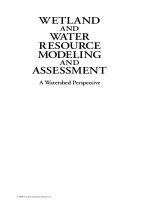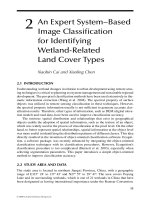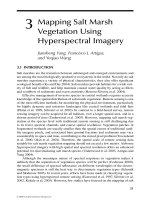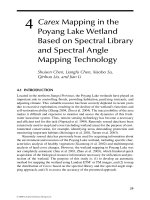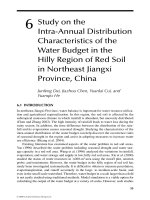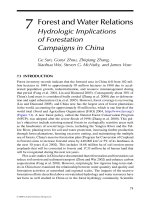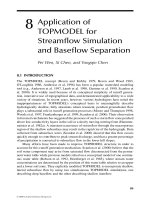WETLAND AND WATER RESOURCE MODELING AND ASSESSMENT: A Watershed Perspective - Chapter 7 pot
Bạn đang xem bản rút gọn của tài liệu. Xem và tải ngay bản đầy đủ của tài liệu tại đây (967.65 KB, 18 trang )
71
7
Forest and Water Relations
Hydrologic Implications
of Forestation
Campaigns in China
Ge Sun, Guoyi Zhou, Zhiqiang Zhang,
Xiaohua Wei, Steven G. McNulty, and James Vose
7.1 INTRODUCTION
Forest inventory records indicate that the forested area in China fell from 102 mil-
lion hectares in 1949 to approximately 95 million hectares in 1980 due to accel-
erated population growth, industrialization, and resource mismanagement during
that period (Fang et al. 2001, Liu and Diamond 2005). Consequently about 38% of
China’s land mass is considered badly eroded (Zhang et al. 2000) due to deforesta-
tion and rapid urbanization (Liu et al. 2005). However, forest coverage is recovering
(Liu and Diamond 2005), and China now has the largest area of forest plantations
in the world, accounting for approximately 45 million ha, which is one fourth of the
world total (Food and Agriculture Organization [FAO] 2004,
(Figure 7.1). A new forest policy, called the Natural Forest Conservation Program
(NFCP), was adopted after the severe oods of 1998 (Zhang et al. 2000). This pol-
icy’s objectives include restoring natural forests in ecologically sensitive areas such
as the headwaters of several large rivers, including the Yangtze River and the Yel-
low River, planting trees for soil and water protection, increasing timber production
through forest plantations, banning excessive cutting, and maintaining the multiple
use of forests. China’s massive forestation plan (Program for Conversion of Cropland
to Forests) aims to increase forested areas by 440,000 km
2
or 5% of its landmass in
the next 10 years (Lei 2002). This includes 14.66 million ha of soil erosion–prone
croplands that will be converted to forests and 17.33 million ha of barren land that
will be revegetated during the next ten years.
Plot-scale studies in China have documented that reforestation and forestation can
reduce soil erosion and sediment transport (Zhou and Wei 2002) and enhance carbon
sequestration (Fang et al. 2001). However, surprisingly, few rigorous long-term stud-
ies in China have examined the relationship between water quantity and quality and
forestation activities at watershed and regional scales. The impacts of the massive
forestation efforts described above on watershed hydrology and water resources have
not been as well studied in China or in the forest hydrology community. Scientic
© 2008 by Taylor & Francis Group, LLC
72 Wetland and Water Resource Modeling and Assessment
debates on the hydrologic role of forests intensied when oods struck, such as in
1981 and 1998.
The objectives of this paper are: (1) to synthesize existing worldwide literature
on the relations between forestation and watershed hydrology, (2) to identify factors
affecting hydrologic responses to forestation, (3) to discuss the potential hydrologic
consequences of large-scale vegetation-based watershed restoration efforts in China,
and (4) to recommend future forest hydrologic research activities to guide watershed
ecological restoration campaigns.
7.2 FORESTS AND WATERSHED HYDROLOGY:
EXPERIMENTAL EVIDENCE AROUND THE WORLD
Many paired watershed manipulation studies addressing forest–water relations have
been conducted in the past 100 years around the world, published in English (Hib-
bert 1967, Bosch and Hewlett 1982, Ffolliott and Guertin 1987, Whitehead and Rob-
inson 1993, Stednick 1996, Sahin and Hall 1996, Scott et al. 2005, Brown et al. 2005,
Farley et al. 2005) as well as in Chinese (Wang and Zhang 1998, Li 2001, Liu and
Zeng 2002, Zhang et al. 2004, Wei et al. 2005b). Key research results in the inter-
national literature and in China are listed in Table 7.1 to facilitate the discussion and
for future reference. Below are examples of the highlights of studies on the effects
of forestation on watershed hydrology grouped by continent. Watershed hydrologic
impact studies are discussed in terms of changes in total annual water yield, storm-
ow rates and volume, and baseow rates and volumes.
IGBP Landuse
BARREN OR SPARSELY VEGETATED
CLOSED SHRUBLANDS
CROPLAND/NATURAL VEGETATION MOSAIC
CROPLANDS
DECIDUOUS BROADLEAF FOREST
DECIDUOUS NEEDLELEAF FOREST
EVERGREEN BROADLEAF FOREST
EVERGREEN NEEDLELEAF FOREST
GRASSLANDS
MIXED FOREST
OPEN SHRUBLANDS
OTHER
PERMANENT WETLANDS
SAVANNA
SNOW AND ICE
WATER
WOODY SAVANNA
FIGURE 7.1 Land cover of China as classied by the IGBP (International Geosphere-
Biosphere Programme) system. (See color insert after p. 162.) The majority of the forest-
lands are located in the hilly remote southwestern and northeastern regions.
© 2008 by Taylor & Francis Group, LLC
Forest and Water Relations 73
7.2.1 NORTH AMERICA
North America contains a diverse mixture of forest ecosystems, from boreal forests
in Canada, in which snow often dominates the hydrologic processes, to semiarid-arid
shrub lands in the southwestern United States where water stress is common. Long-
term experimental stations, including the Coweeta Hydrologic Laboratory, Hubbard
Brooks, and Andrews Experimental Forests in the United States (Figure 7.2), and
the Turkey Lakes Watershed Study in Canada, were designed to answer watershed
management questions specically related to water quantity and quality. Many of
the experimental watersheds have provided over 50 years of continuous forest hydro-
logic data. Much of our current understanding of modern forest hydrological and
ecosystem processes has been derived from these watersheds.
TABLE 7.1
Key publications on forest–water relations.
References Region Ecosystems Key Findings
Bosch and Hewlett 1982 Worldwide; all
ecosystems
Annual evapotranspiration decreases with
vegetation removal
Andreassian 2004 Worldwide, all ecosystems Deforestation (reforestation) increases
(decreases) water yield; the variability can be
explained by differences in climate, soil, and
vegetation characteristics
Jackson et al. 2005 Worldwide, all
ecosystems
Plantations reduce stream ow, and increases
soil salinization and acidication
Ice and Stednick 2004 United States; all type of
forests
Deforestation increases water yield
Beschta et al. 2000 Western Cascade of
Oregon, United States
Forest harvesting increases small-sized peak
ows; not likely to cause peak ow increases
in large basins
Scott et al. 2005 South Africa and Tropics;
forest plantations
Converting grasslands or reforesting degraded
lands with plantations reduce base ow and
water yield; little impacts on peak ows
Robison et al. 2003 European forest
ecosystems
Similar results to North America; forests play
small role in water resource management for
oods and droughts
Brown et al. 2005 Australia and worldwide;
all forest ecosystems
Variable hydrologic recovery time for
deforestation and reforestation, which mainly
impact base ows
Ma 1987 Sub-alpine, southwestern
China
Water yield increased after forest harvesting
treatment
Liu and Zhong 1978 Loess Plateau, China Water yield was lower in forested watersheds
Wei at al. 2005a, 2005b China Contradictory data on forest–water relations
Sun et al. 2006 China Simulated water yield reduction following
reforestation most signicant in northern
regions
© 2008 by Taylor & Francis Group, LLC
74 Wetland and Water Resource Modeling and Assessment
Experimental results in the United States have been synthesized by Hibbert
(1967), Bosch and Hewlett (1982), in a special issue of the American Water Resource
Bulletin published in 1983, by Post and Jones (2001), and more recently in a book by
Ice and Stednick (2004). Canadian forest hydrology research activities were sum-
marized by Buttle et al. (2000, 2005). Long-term empirical data across the physio-
graphic gradients in the United States suggest diverse watershed hydrologic response
to forest removal (Figure 7.2). For example, a 46-year paired watershed study at the
Coweeta Hydrologic Laboratory in a humid subtropical climate with deep soils shows
that repeated cutting of mountain forests can increase streamow by 200 to 400
mm per year. The hydrologic effects lasted more than 20 years (Swank et al. 1988).
Streamow decreased with the regeneration and regrowth of the deciduous forests. A
second cutting returned to pretreatment water yield faster than the rst cutting cycle
(Figure 7.3). Hydrologic responses differ across landscapes (i.e., upland vs. wetlands)
and climatic conditions (Sun et al. 2004, Sun et al. 2005). Several eld and modeling
studies in the southeastern United States showed that forest management impacts on
water yield were most pronounced during dry periods when trees that have deep roots
can use moisture in subsurface soil layers (Trimble and Weirich 1987, Sun et al. 1998,
Burt and Swank 2002). The effects of forests on annual water yield are propagated
through their inuence on baseow. North American literature on forestry impacts
on oods is more contentious (Jones and Grant 1996, Thomas and Megahan 1998,
Beschta et al. 2000) than on annual water yield and baseow. However, it is generally
accepted that forest management affects small to moderate peak ow rates, but has
little impact on large oods (Hewlett 1982, Burt and Swank 2002).
Reviews of Canadian forest hydrology by Buttle et al. (2000, 2005) concluded
that watershed-scale studies to evaluate the hydrologic effects of large-scale forest
FIGURE 7.2 First-year water yield response to deforestation (clear-cut) varies across the
physiographic gradient in the United States.
© 2008 by Taylor & Francis Group, LLC
Forest and Water Relations 75
removal for managing recent re and insect disturbances are lacking in Canada.
Limited watershed manipulation studies suggest that drainage through ditching
increased baseow, but not peak ow in a Quebec peat land. Peak ow rates were not
affected signicantly in a watershed in New Brunswick with a 23.4% forest removal.
Buttle et al. (2005) cautioned that importation and direct application of results from
other regions in the United States to Canada may not be appropriate due to the unique
geological (i.e., glacier vs. nonglacier) and climatic conditions (e.g., snow dominated
vs. rain dominated), and because the treatment methods used in the 1960s and 1970s
by U.S. researchers are no longer in use.
7.2.2 EUROPE
Forest is a major land cover type in Europe, and recent droughts and oods have
attracted new interest in the role of forests in inuencing river ow regimes. In a
synthesis study across the European continent, Robinson et al. (2003) found that
conifer plantations on poorly drained soils in northwestern Europe and eucalyp-
tus in southern Europe may have marked local impacts on water yield similar to
those reported in North America. However, changes of forest cover will not likely
have great effect on extreme ows (i.e., oods and droughts) at the regional scale.
0
5
10
15
20
25
30
35
40
1 2 3 4 5 6 7 8 9 1011121314151617181920212223
Years Post-Treatment
Actual Minus Predicted Streamflow (cm)
First Treatment
Second Treatment
First Treatment
Second Treatment
FIGURE 7.3 Annual streamow responses to repeated harvesting of mixed hardwood for-
est on watershed 13 at the Coweeta Hydrologic Laboratory located in the southern Appa-
lachian Mountains. (Adapted from Swank et al. 1988, Streamow changes associated with
forest cutting, species conversion, and natural disturbances. In Ecological studies. Vol. 66,
Forest hydrology and ecology at Coweeta, ed. W. T. Swank and D. A. Crossley Jr. New York:
Springer-Verlag, 297–312.)
© 2008 by Taylor & Francis Group, LLC
76 Wetland and Water Resource Modeling and Assessment
Robinson et al. (2003) stress the dilution effects of water ow for large basins, and
conclude that forests have a relatively small role in managing risks of large-scale
oods and droughts across the region.
7.2.3 SOUTH AFRICA AND THE TROPICS
It is estimated that 40 to 50 million ha of forest plantations grow in the tropics and
warmer subtropics with an additional 2 to 3 million ha planted every year (Scott et
al. 2005, Farley et al. 2005). The hydrologic impacts of forestation are more pro-
nounced in this region due to the high water uptake by tropical trees. For example,
some studies have recorded water yield increase of 80 to 90 mm per year per 10%
forest removal (Bruijnzeel 1996, Bruijnzeel 2004). The response is much higher than
the 25 to 60 mm per year range in the classic synthesis paper by Bosch and Hewlett
(1982). A review of the literature on the humid tropical regions suggests the pros-
pects of enhanced rainfall and augmented baseow from reforestation are generally
poor in most areas (Scott et al. 2005). A long-term (since the 1930s) paired watershed
study for converting natural grasslands to forests with negative or exotic tree species
in South Africa provided a comprehensive understanding of the hydrologic effects
of forestation (Smith and Scott 1997, Scott et al. 1998). This study found that annual
streamow reduction rates increased over time following a similar sigmoidal pattern
of tree growth. The highest ow reductions occurred when the plantations reached
maturity. For every 10% level of planting, the reductions varied from 17 mm (or 10%
per year) in a drier watershed to 67 mm (or 7% per year) for a wetter watershed. The
low and high values are similar to those found in South India and Fiji respectively,
and are within the range noted by Bosch and Hewlett (1982). This South Africa for-
estation study found that it took two years to have an appreciable reduction in stream-
ow after Eucalyptus grandis was planted over 97% of a native grassland watershed.
However, it took eight years to have a clear streamow impact after Pinus patula was
planted over 86% of a native grassland watershed. The former reached the maximum
streamow reduction potential in about 15 years, while the latter did not reach the
maximum reduction 25 years after planting. A recent update on this study reported
that the reductions diminished after the plantations reached maturation, suggesting
productive, vigorous growing forests use more water than mature or old, less vigor-
ous growth forests (Scott et al. 2005). Finally, this long-term study concluded that
forestation reduced total stream water yield, mostly baseow, and can result in the
complete loss of streamow during the summer. Scott et al. (2005) postulated that
the effect of forestation on streamow decreased with storm size, and forestation
had little effect on large storms when the soil conditions were not affected. Storm-
ows were mostly affected by soil water storage capacity and antecedent soil mois-
ture conditions. Researchers in the tropics stressed the importance of differentiating
degraded lands with bad soils versus undisturbed good soils that have very different
soil hydrologic properties and processes when evaluating the effects of forestation
on watershed hydrology (Bruijnzeel 2004, Scott et al. 2005). However, few denitive
conclusions can be drawn from the literature on how forestation affects stormows
and baseows. Few available studies suggest that revegetating degraded watersheds
is not likely to augment baseow and reduce stormow volumes.
© 2008 by Taylor & Francis Group, LLC
Forest and Water Relations 77
7.2.4 AUSTRALIA
Paired watershed manipulation studies in Australia produced a large amount of
process-based information and useful models studying the effects of forestation on
streamow (Vertessy 1999, 2000; Zhang et al. 2001). Several Australian studies con-
cluded that vigorous tree regrowth on cleared watersheds that were previously cov-
ered by old growth forests (e.g., mountain ash) resulted in decreased water yield due
to increased evapotranspiration. Water yield from eucalyptus forests was found to be
closely related to tree age (Cornish and Vertessy 2001, Vertessy et al. 2001). Vertessy
and Bessard (1999) warned about the potential negative hydrologic effects (reduction
of streamow) of large-scale plantation expansion in Australia basins.
Andreassian (2004) and Brown et al. (2005) reviewed worldwide paired watershed
experiments located in various geographic regions around the world. Highlights of the
recent synthesis studies are summarized below with a focus on forestation effects.
The paired watershed experiments have crucial values in understanding the
forest–water relationships. Existing paired watershed experiments are mostly
designed for studying the effects of deforestation. Studies on reforestation are rare.
Flow duration curve analysis methods provide insights on the seasonal effects of
vegetation changes.
In general, deforestation increases annual water yield, and reforestation decreases
it in proportion to vegetation cover change (Sun et al. 2006, Figure 4). Seasonal
water yield response is variable (Brown et al. 2005), and is strongly inuenced by
precipitation patterns.
In general, deforestation increases ood volumes and peaks due to soil distur-
bances, but the effect is extremely variable. Limited studies on reforestation sug-
gested that revegetation had minimal effect on small to moderate oods, and had no
effect on ooding events.
Deforestation increases low ow (baseow) and reforestation decreases it (Far-
ley et al. 2005, Jackson et al. 2005).
7.3 DEBATE ON FOREST–WATER RELATIONS IN CHINA
Flooding and drought events cause huge economic losses each year in this heav-
ily populated country. The Chinese people have long recognized the importance
of forest and water to the environment and human societal development (Yu 1991).
Because of the uncertainty of the relations between water resources and forests (Wei
et al. 2005), great confusion and misconceptions regarding the hydrologic role of
forests remain today (Zhou et al. 2001).
In the 1980s, studies on forest–water relations began to emerge in China (Ffol-
liott and Guertin 1987). Most of the studies have focused on the benets of forests
in retaining water for discharge during non-rainfall seasons (water redistribution)
and on reducing oods during rainy seasons. Unfortunately, empirical observation
and limited data on the environmental inuences of forests, especially on hydrologic
cycles, are often inconclusive and even contradictory (Wei et al. 2003, Wei et al.
2005) due to the highly diverse hydrologic processes caused by the large geographic
and climatic variability in China.
© 2008 by Taylor & Francis Group, LLC
78 Wetland and Water Resource Modeling and Assessment
Nevertheless, several well-cited studies have demonstrated the uncertainty and
variability of potential hydrologic responses in China because of the large differ-
ences in climate and soil conditions. Liu and Zhong (1978) reported that forested
watersheds on loess soils had a lower water yield amount (25 mm/yr) and a lower
water yield/precipitation ratio than adjacent nonforest regions. This work was based
on water balance data of several large basins in the upper reaches of the Yellow
River in northwestern China. It was further estimated that forests in the Loess Pla-
teau region may reduce annual streamow by 37%. This study suggested that for-
ested watersheds had higher total evapotranspiration, lower surface ow, but higher
groundwater ow (baseow). A three-year study in a small watershed in the middle
reach of the Yellow River concluded that well-vegetated watersheds dominated by
black locust (Robinia pseudoacacia) plantations and native pine species had over
100 mm per year higher evapotranspiration than the nonvegetated watersheds (Yang
et al. 1999). Stormow volume and peak ow rates were lower in the vegetated
watersheds. The average annual precipitation was about 400 mm. Greater than 95%
of precipitation evapotranspirated, and less than 5% precipitation became stream-
ow as inltration-excess overland ow. The high tree density of plantations in the
Loess Plateau region has resulted in low soil moisture in the rooting zone, which
threatens the tree productivity and overall sustainability of the forestation efforts. A
rare paired watershed experiment at a hardwoods forest site in northeastern China
(annual precipitation = 700 to 800 mm) concluded that a 50% thinning caused total
runoff to increase 26 to 31 mm per year (Ma 1993). However, several rather con-
tradictory reports also exist. For example, Ma (1987) compared runoff between an
old-growth r forest watershed and a clear-cut watershed in the subalpine region
of southwestern China, a tributary of the Yangtze River. This study was conducted
in 1960, and found that water yield from the 331-ha forested watershed was much
higher (709 mm/yr and a runoff ratio of 70.2%) than the 291-ha clear-cut watershed
(276 mm/yr and a runoff ratio of 27.3%). In 1969, 60% of the forested watershed was
harvested and water yield decreased by 380 mm per year. Detailed explanation of the
causes of the hydrologic changes were not provided.
A comparison of streamow from ten large basins (674 to 5,322 km
2
) in the
Yangtze River showed that higher forest coverage generally had a higher runoff-to-
rainfall ratio (>90%) (Ma 1987). Similar positive correlations between forests and
water yield for large basins (>100 km
2
) were reported for northern China as cited in
Wei et al. (2003). These ndings corroborate Russian literature that suggests stream-
ow is generally higher for large forested basins (Wei et al. 2003). One unsubstanti-
ated argument on the increase of streamow from forests was that forest increased
fog drip precipitation and that forests have lower evapotranspiration. Reports from
studies in Russia on the forest–water relations had a large impact in China before the
1980s when access to Western literature was limited.
Wei et al. (2003) attributed the inconsistency of the studies described above
to several reasons: (1) heterogeneous large basins have a large buffering capacity
(e.g., wetlands) and may mask the forest cover effects, (2) inconsistent methods and
measurement errors, and (3) differences in climate and watershed characteristics
among the contrasting basins may obscure the forest cover effects. In fact, most of
the watershed studies in China presented above did not follow the paired watershed
principles, thus conclusions are subject to errors.
© 2008 by Taylor & Francis Group, LLC
Forest and Water Relations 79
Sun et al. (2006) examined the sensitivity of water yield response to foresta-
tion across China by employing a simple evapotranspiration model (equation 7.1)
developed by Zhang et al. (2001) and a set of continental-scale databases includ-
ing climate, topography, and vegetation (Sun et al. 2002). The Zhang et al. (2001)
model was recently evaluated by Brown et al. (2005) using worldwide paired water-
shed studies. They found that the model is satisfactory at predicting the hydrologic
effects of forestation of hardwoods and eucalyptus, but underestimates the effects for
conifers. The model application study by Sun et al. (2006) concluded that foresta-
tion would have variable potential impacts across the diverse physiographic region
(Figures 7.5 and 7.6). On average, the absolute values of reduction in water yield due
to forestation ranged from approximately 50 mm per year in the drier northern region
to about 300 mm per year to the southern humid region. This represents a 40% and
20% water yield reduction in the north and south, respectively. The predicted water
yield reduction values reect the climate (i.e., precipitation and potential evapotrans-
piration) controls on hydrologic responses to forestland cover changes. The predicted
hydrologic responses are in the lower end of reported values when compared to the
worldwide literature (Figure 7.4).
0
–800
–600
–400
–200
0
200
400
600
800
20 40 60 80 100
Percentage of Treated Watershed (%)
Maximum Variation in Annual Flow Following
Watershed Treatment (mm)
Deforested Watersheds
Reforested Watersheds
FIGURE 7.4 Worldwide review of paired watershed experiments on the stream ow
response to deforestation and reforestation. (From V. Andreassian, Waters and forests: from
historical controversy to scientic debate. Journal of Hydrology 291:1–27.)
© 2008 by Taylor & Francis Group, LLC
∆Q ET ET
PET
P
PET
P
P
PET
PE
= − = −
+
+ +
−
+
1 2
1 20
1 20
1 05.
.
.
TT
P
PET
P
P
PET
P
1 05+ +
×
.
(7.1)
where ΔQ = annual water yield change; ET
1
, ET
2
= evapotranspiration of forest lands
and grasslands, respectively; P = annual precipitation; PET = potential evapotrans-
piration calculated using Hamon’s method as a function of monthly air temperature
(Federer and Lash 1978).
80 Wetland and Water Resource Modeling and Assessment
This analysis was based on the assumption that future precipitation and poten-
tial evapotranspiration do not change. A changing climate will certainly result in a
different scenario on forestation impacts. There is some evidence that overall eco-
system productivity has been increasing across China in the past decade (Fang et al.
2003). The increasing trend of productivity may indicate an increasing trend of water
use because water is tightly coupled to ecosystem productivity in general (Jackson
et al. 2005).
7.4 IMPLICATIONS OF FOREST–WATER RELATIONS
TO FORESTATION CAMPAIGNS IN CHINA
Worldwide research on forest–water relations in the past few decades provides a basis
for projecting the hydrologic consequences of forestation efforts. We now know that
in general, forests provide the best water quality since soil erosion in undisturbed
forests is extremely low. However, they do use more water than other nonirrigated
crops that have less root mass and shallower rooting depth. Potential streamow
reduction from reforestation is of great concern (Jackson et al. 2005, Sun et al. 2006).
Forestation activities have limited effects on volume and peaks of large oods. Also,
there is much variability of hydrologic responses to forestation.
Based on reviewed literature, we expect large spatial and temporal variability of
hydrologic response to forestation because of the large gradients in climate (Sun et al.
2006), topography, soils, degree of disturbances, and stage of vegetation recovery in
China. Those factors are well discussed in Andreassian (2004) and Scott et al. (2005).
Water Yield Decrease
(mm/Yr.)
15 – 100
100 – 150
150 – 200
200 – 250
250 – 321
FIGURE 7.5 Predicted potential annual water yield reduction (mm/yr) due to the conver-
sion of grasslands to forest lands, showing a strong increasing gradient from the dry and
cold northwest to the warm and wet southeast. (See color insert after p. 162.) Regions with
annual precipitation of less than 400 mm per year are not appropriate for reforestation and
were excluded from the analysis. (From Sun et al. 2006, Potential water yield reduction due
to reforestation across China. Journal of Hydrology, 328:548–558.)
© 2008 by Taylor & Francis Group, LLC
Forest and Water Relations 81
Although caution is needed to extrapolate studies from one region to others, existing
literature has important implications for the current reforestation efforts in China.
1. Forestation or converting from rain-fed croplands to tree plantations will
likely reduce total annual streamow. Most literature clearly shows this
conclusion because trees generally use more water than crops that have a
short growing season and shallow rooting depth (Andreassian 2004). In
China, exotic, fast-growing tree species such as larch, eucalyptus, and pop-
lars are often used for timber production. Trees used for soil erosion control
also often have economic considerations either for wood or fruit production.
Those trees usually use more water than the native tree or shrub species.
2. Forestation is not likely to reduce stormow volumes and peak ow rates,
therefore forestation is not likely reduce large-scale oods. It is noteworthy
to point out that a majority of the lands considered as viable candidates for
forestation in China have chronic severe soil erosion problems. Such soils
normally have degraded hydrologic properties that retard inltration and
therefore increase overland ow (Scott et al. 2005). Revegetation can improve
soil properties such as increasing hydraulic conductivity and macroporosity.
However, it may even take a long time for vegetation to affect soil inltration
capacity, and eventually stormow peaks and volumes. Stormow volumes
and peak ow rates are mostly controlled by soil water storage capacity (i.e.,
% Water Yield Decrease
3–10
10–20
20–30
30–40
40–55
FIGURE 7.6 The potential water yield reduction as a percentage of water yield from pre-
vious grasslands following reforestation shows a strong decreasing gradient from the dry
and cold northwest to the warm and wet southeast. (See color insert after p. 162.) Refor-
estation activities in the Yellow River basins will have a more pronounced impact than in
the Yangtze River basins. Regions with annual precipitation of less than 400 mm per year
are not appropriate for reforestation and were excluded from the analysis. (From Sun et al.
2006, Potential water yield reduction due to reforestation across China. Journal of Hydrol-
ogy, 328:548–558.)
© 2008 by Taylor & Francis Group, LLC
82 Wetland and Water Resource Modeling and Assessment
soil depth and porosity). Large oods normally occur when the canopy and
litter interception capacity and soil water storage have been lled, thus veg-
etation has very limited inuences on ooding during large storm events.
Antecedent soil moisture conditions are important when evaluating the role
of forests in reducing peak ow rates. Brown et al. (2005) studied the sea-
sonal effects of deforestation and forestation and concluded that those activi-
ties had higher impacts on baseows than other types of ows.
3. Forestation is not likely to augment baseows and spring occurrences. Base-
ows are streamows during non-rainfall periods originating from ground-
water and soil water storage reservoirs. Compared to heavily degraded
watersheds, it is generally true that undisturbed forests that have a thick
litter layer and porous soils can store a greater amount of precipitation and
release it gradually as spring waters. However, forestation on degraded lands
is not likely to increase groundwater storage capacity and soil water storage
in the short term. The increased ltration due to vegetation establishment
may be exceeded by the increased water loss by evapotranspiration of the
newly established forest (Scott et al. 2005). We predict that baseow reduc-
tions are most pronounced in northern China where water stress is common
throughout the growing season. Tree plantings on old oodplains and dried
channel beds, and the Loess Plateau regions with deep soils are most likely
to have impacts on groundwater recharge, soil moisture, and baseow. For-
estation in wetland-dominated watersheds may have little effect on overall
watershed hydrology since water balances (i.e., evapotranspiration) are not
likely to change signicantly (Sun et al. 2000). Actual evapotranspiration
in wetlands is generally close to potential evapotranspiration regardless of
vegetation conditions. Therefore, in contradiction to the general perception
that forests augment low ow or have more natural springs, forestation may
actually reduce baseow in the short term.
4. The hydrologic effects of forestation will be small in the short term. Defor-
estation has immediate effects on streamow, but it takes longer for the
trees to grow back to a mature forest (Brown et al. 2005). It takes even
longer for degraded lands to develop into well-functioning forests across
the temperate and boreal regions in northern China. It may take less time
for tree establishment in warm, humid southern China where the climate is
optimum for tree growth. However, nutrients often limit tree growth due to
past chronic soil erosion. Therefore, we expect that the watershed hydrol-
ogy of many newly forested sites will not cause large changes in the short
term unless signicant mechanical site preparation activities (i.e., terrac-
ing) have altered the soil hydrologic properties. This is especially true for
degraded soils that have been chronically eroded and whose soil physical
properties are damaged. A recent review on the impacts of mechanical dis-
turbance on soil properties suggests that soil natural recovery from com-
paction may take several decades (National Council for Air and Stream
Improvement [NCASI] 2004). A simple conceptual model was developed
to illustrate the effects of forestation on water yield over time across major
regions in China (Figure 7.7). The model suggests hydrologic recovery rates
depend on climate, soil, and vegetation reestablishment.
© 2008 by Taylor & Francis Group, LLC
Forest and Water Relations 83
Our discussion on forestation has been focused on the impact potential for basins
subjected to complete cover change from bare lands or grasses and crops. This type
of change is very unlikely to happen for large basins in China even under the current
massive forestation campaigns because large areas of cropland are needed to meet
the food demands in the rural areas. As shown in Figure 4 in Andreassian’s (2004)
review, the forestation effect on streamow closely correlates to the percentage of
land cover change. Our discussion has ignored the effects of soil and water conserva-
tion practices such as contouring, terracing and other bioengineering methods. Those
practices may enhance inltration, increase surface roughness, and consequently
may have impacts on water balances, stormow and baseow characteristics.
7.5 FOREST HYDROLOGY RESEARCH NEEDS IN CHINA
Most of the existing forest hydrologic studies in China focused on single processes
at the eld scale (Zhang et al. 2000, Zhou et al. 2002, Zhou et al. 2004, Chen 1995).
Integrated watershed-scale experiments and monitoring to evaluate the overall
hydrologic response to forestation are rare. There is an urgent need to rigorously
evaluate the hydrologic consequences of forestation, which is a key component of
national “environmental reconstruction” (Zhou et al. 2001).
Andreassian (2004) raised seven important issues that require attention in study-
ing forest–water relations at the watershed scale: (1) watershed size, (2) using models
to mimic a control basin, (3) forest descriptors, (4) gradual changes, (5) long-term
impacts, (6) distinguish forest stands from forest soils, and (7) number of watersheds.
Those recommendations are quite pertinent to understanding and predicting the
effects of reforestation in China.
0 10203040506070
Time (years)
100
200
300
Decrease in Water Yield (mm)
Potential Impact of Reforestation on Water Yield in China
Southern Region (Warm, wet, shallow soils)
Southern Region (Cool, wet, shallow soils)
Northeastern Region (Cold, moist, deep soils)
Loess Plateau Region (Cool, dry, deep soils)
Northern Region (Cool, dry, shallow soils)
FIGURE 7.7 A conceptual model illustrating the gradual reductions of annual water yield
following forestation across the major geographic regions in China. (From Sun et al. 2006,
Potential water yield reduction due to reforestation across China. Journal of Hydrology,
328:548–558.)
© 2008 by Taylor & Francis Group, LLC
84 Wetland and Water Resource Modeling and Assessment
Worldwide forest hydrology studies in the past century demonstrated that the
paired watershed approach is the best way to detect land cover change effects on
hydrology (Brown et al. 2005). The paired watershed approach removes the climatic
variability effects on watershed hydrology between two watersheds that have dif-
ferent vegetation covers. However, to date there are no long-term paired watershed
experiments that could give substantial answers on the impact of forests on water-
shed hydrology for any of the regions in China. Existing national ecological moni-
toring networks, such as China Ecological Research Network (CERN) and China
Forestry Ecological Network (CFEN), promise to provide useful results on fores-
tation impacts on hydrology. A paired watershed approach with a long-term plan
should be adopted across China.
Another way of examining land use change on hydrology is by simulation mod-
els. Computer modeling has been well accepted by the hydrologic community as an
effective way to examine individual hydrologic processes and separate the roles of
various factors (soil, climate, and plant growth status) (Sun et al. 1998, Deng and Li
2003, Yu et al. 2003). Computer simulation models may play a key role since most
of the rivers in China are not gauged, especially in remote areas where hydrologic
characteristics are unique. However, development, parameterization, calibration, and
validation for simulation models require a large amount of eld data, which are often
expensive to obtain. Models must be built upon quality experimental data and model
simulations require accurate input climatic drivers and parameters. To fully under-
stand the role of land cover change on the water cycles, such as precipitation, meso-
scale distributed computer models are needed to account for the feedbacks between
land and climate. Such types of models require even more close integration of
remotely sensed spatial databases and energy and water balances. Meso-scale mod-
els are becoming increasing operational at the regional scale (Chen et al. 2005).
When evaluating the hydrologic effects of forestation on degraded lands in China,
it is important to recognize the different roles of vegetation and soils (Bruijnzeel
2004, Wei et al. 2005). Systematic and long-term research is needed to document
the recovery process of soil hydrologic properties along with changes of forest water
use during the entire life cycle of plantation trees. In addition, the hydrologic effects
of the soil and water conservation measures (e.g., contouring and terracing) that are
often employed in forestation on degraded lands need to be evaluated. It is necessary
to separate the roles of vegetation from engineering in inuencing watershed hydrol-
ogy to maximize the ecologic benets of forestation and forestation planning.
The diverse physiographic regions in China provide an excellent location to test
hypotheses generated elsewhere around the world. Several unique watershed settings
such as the Loess Plateau (i.e., dry, deep soils) and the upper reaches of the Yangtze
River (i.e., wet, cold, steep slopes, shallow soils) may have unique responses to foresta-
tion. A process-based approach is needed to address the delicate differential responses to
vegetation management among these different geophysical conditions (Wilcox 2002).
ACKNOWLEDGMENTS
This study was supported by the U.S. Department of Agriculture Forest Service South-
ern Global Change Program, in collaboration with the Southern China Botany Garden,
© 2008 by Taylor & Francis Group, LLC
Forest and Water Relations 85
Chinese Academy of Science. Partial support is also provided by the China Key Basic
Research Program (973 Program) Inuence and Control of Forest Vegetation Covers
on Agricultural Ecological Environments in Western China (2002CB111502).
REFERENCES
Andreassian, V. 2004. Waters and forests: From historical controversy to scientic debate.
Journal of Hydrology 291:1–27.
Beschta, R. L., M. R. Pyles, A. E. Skaugset, and C. G. Sureet. 2000. Peakow responses
to forest practices in the western Cascades of Oregon, USA. Journal of Hydrology
233:102–120.
Bosch, J. M., and J. D. Hewlett. 1982. A review of catchment experiments to determine the
effect of vegetation changes on water yield and evapotranspiration. Journal of Hydrol-
ogy 55:3–23.
Brown, A. E., L. Zhang, T. A. McMahon, A. W. Western, and R. A. Vertessy. 2005. A review
of paired catchment studies for determining changes in water yield resulting from alter-
ations in vegetation. Journal of Hydrology 310:28– 61.
Bruijnzeel, L. A., 1996. Predicting the hydrologic effects of land cover transformation in
humid tropics: The need for integrated research. In Amazonian deforestation and cli-
mate, ed. J. H. Gash, C. A. Nobre, J. M. Roberts, and R. L. Victoria. Chichester, UK:
J. Wiley, 15–55.
Bruijnzeel, L. A., 2004. Hydrological functions of tropical forests: Not seeing the soils for the
trees. Agriculture Ecosystems and Environment 104:185–228.
Burt, T., and W. T. Swank. 2002. Forest and oods? Geography Review 15(5):37–41.
Buttle, J. M., I. F. Creed, and J. W. Pomeroy. 2000. Advances in Canadian forest hydrology,
1995–1998. Hydrological Processes 14(9):1551–1578.
Buttle, J. M., I. F. Creed, and R. D. Moore. 2005. Advances in Canadian forest hydrology,
1999–2003. Hydrological Processes 19:169–200.
Chen, L. 1995. Inltration rates of loess soils in a plantation for soil and water conservation
[in Chinese]. Journal of Beijing Forestry University 17(3):51–55.
Chen, M., D. Pollard, and E. J. Barron. 2005. Hydrologic processes in China and their asso-
ciation with summer precipitation anomalies. Journal of Hydrology 301:14–28.
Cornish, P. M., and R. A. Vertessy. 2001. Forest age–induced changes in evapotranspiration
and water yield in eucalypt forest. Journal of Hydrology 242:43–63.
Deng, H., and X. Li. 2003. Simulation of hydrologic response to land cover changes [in Chi-
nese]. Scientia Geographica Sinica 58(1):1–5.
Fang, J., A. Chen, C. Peng, S. Zhao, and L. Ci. 2001. Changes in forest biomass carbon stor-
age in China between 1949 and 1998. Science 292:2320–2322.
Fang, J., S. Piao, C. B. Field, Y. Pan, Q. Guo, L. Zhou, and C. Peng. 2003. Increasing new primary
production in China from 1982 to 1999. Frontiers Ecological Environment 6:293–297.
Farley, E. G., J. B. Jobbagy, and Jackson. 2005. Effects of afforestation on water yield: A
global synthesis with implications for policy. Globe Change Biology (11):1565–1576.
Federer, C. A., and D. Lash. 1978. BROOK: A hydrologic simulation model for eastern for-
ested. Research Report 19. Durham: Water Resources Research Center, University of
New Hampshire.
Ffolliott, P., and D. P. Guertin, eds. 1987. Forest Hydrologic Resources in China: An Analyti-
cal Assessment. Proceedings of a Workshop, Harbin, China. August 18 –23. Washing-
ton, DC: United States Man and the Biosphere Program.
Hewlett, J. D. 1982. Forests and oods in the light of recent investigation. In Hydrologi-
cal processes of forested areas. National Research Council of Canada Publication no.
20548, Ottawa: NRCC, 543–559.
© 2008 by Taylor & Francis Group, LLC
86 Wetland and Water Resource Modeling and Assessment
Hibbert, A. R. 1967. Forest treatment effects on water yield. In Forest hydrology, proceedings
of a National Science Foundation Advanced Science Seminar, ed. W. E. Sopper and H.
W. Lull. Oxford: Pergamon Press, 527–543.
Ice, G. G., and J. D. Stednick. 2004. A century of forest and wildland watershed lessons.
Bethesda, MD: Society of American Foresters, 287.
Jackson, R. B., 2005. Trading water for carbon with biological carbon sequestration. Science
1944–1947.
Jones, J. A., and G. E. Grant. 1996. Long-term stormow responses to clearcutting and
roads in small and large basins, western Cascades, Oregon. Water Resources Research
32:959–974.
Lei, J. 2002. China’s implementation of six key forestry programs. scientist.
com/article.ns?id=dn2291.
Li, W. 2001. A summary of perspective of forest vegetation impacts on water yield [in Chi-
nese]. Journal of Natural Resources 16:398–405.
Liu, C., and Y. Zeng. 2002. Effects of forests on water yield [in Chinese]. Special issue of
Hydraulic Research in China (October):112–117.
Liu, C M., and J. Zhong. 1978. Effects of forests on annual streamow in the Loess Plateau
region [in Chinese]. Acta Geographica Sinica 33:112–126.
Liu, J., and J. Diamond. 2005. China’s environment in a globalizing world. Nature
43:1179–1186.
Liu, J., H. Q. Tian, M. Liu, D. Zhuang, J. M. Melillo, and Z. Zhang. 2005. China’s changing
landscape during the 1990s: Large-scale land transformation estimated with satellite
data. Geophysical Research Letters 32: L02405, doi:10.1029/2004GL021649.
Ma, X. 1987. Hydrologic processes of a conifer forest in the sub-alpine region in Sichuan,
China [in Chinese]. Scientia Silvae Sinicae 23:253–265.
Ma, X. 1993. Forest hydrology [in Chinese]. China Forest Publication House, 398.
NCASI (National Council for Air and Stream Improvement). 2004. Effects of heavy equip-
ment on physical properties of soils and long-term productivity: A review of litera-
ture and current research. Technical Bulletin No. 887. Research Triangle Park, NC:
National Council for Air and Stream Improvement, Inc.
Post, D. A,. and J. A. Jones. 2001. Hydrologic regimes of forested, mountainous, headwa-
ter basins in New Hampshire, North Carolina, Oregon, and Puerto Rico. Advances in
Water Resources 24:1195–1210.
Robison, M. A L. et al. 2003. Studies of the impact of forests on peak ows and baseows: A
European perspective. Forest Ecology and Management 186:85–97.
Sahin, V., and M. J. Hall. 1996. The effects of afforestation and deforestation on water yields.
Journal of Hydrology 178:293–309.
Scott, D. F., L. A. Bruijnzeel, and J. Mackensen. 2005. The hydrologic and soil impacts of
reforestation. In Forests, water and people in the humid tropics, ed. M. Bonell and L.
A. Bruijnzeel. Cambridge: Cambridge University Press, 622–651.
Scott, D. F., D. C. Le Maitre, and D. H. K. Fairbanks. 1998. Forestry and streamow reduc-
tions in South Africa: A reference system for assessing extent and distribution. Water
SA 24:187–199.
Stednick, J. D. 1996. Monitoring the effects of timber harvest on annual water yield. Journal
of Hydrology 176:79–95.
Sun, G., S. G. McNulty, J. Lu, D. M. Amatya, Y. Liang, and R. K. Kolka. 2005. Regional
annual water yield from forest lands and its response to potential deforestation across
the southeastern United States. Journal of Hydrology 308:258–268.
Sun, G, S. G. McNulty, J. Moore, C. Bunch, and J. Ni. 2002. Potential impacts of climate
change on rainfall erosivity and water availability in China in the next 100 years. Pro-
ceedings of the 12th International Soil Conservation Conference. Beijing, China, May
2002. 244–250.
© 2008 by Taylor & Francis Group, LLC
Forest and Water Relations 87
Sun, G., H. Riekerk, and N. B. Comerford. 1998. Modeling the hydrologic impacts of for-
est harvesting on atwoods. Journal of American Water Resources Association
34:843–854.
Sun, G., H. Riekerk, and L. V. Korhnak. 2000. Groundwater table rise after forest harvesting
on cypress-pine atwoods in Florida. Wetlands 20(1):101–112.
Sun, G., M. Riedel, R. Jackson, R. Kolka, D. Amatya, and J. Shepard. 2004. Inuences of
management of southern forests on water quantity and quality. In Southern forest sci-
ence: Past, present, and future. Asheville, NC: U.S. Department of Agriculture, Forest
Service, Southern Research Station, 195–224.
Sun, G., G. Zhou, Z. Zhang, X. Wei, S. G. McNulty, and J. M. Vose, 2006. Potential water
yield reduction due to reforestation across China. Journal of Hydrology 328:548–558.
Swank, W. T., L. W. Swift Jr., and J. E. Douglass. 1988. Streamow changes associated with
forest cutting, species conversion, and natural disturbances. In Ecological studies. Vol.
66, Forest hydrology and ecology at Coweeta, ed. W. T. Swank and D. A. Crossley Jr.
New York: Springer-Verlag, 297–312.
Thomas, R. B., and W. F. Megahan. 1998. Peak ow responses to clear-cutting and roads in
small and large basins, western Cascades, Oregon: A second opinion. Water Resources
Research 37(1):175–178.
Trimble, S. W., and F. H. Weirich. 1987. Reforestation reduces streamow in the southeastern
United States. Journal of Soil and Water Conservation 42(4): 274–276.
Vertessy, R. A., 1999. The impacts of forestry on streamows: A review. In Forest manage-
ment for the protection of water quality and quantity: Proceedings of the second ero-
sion in forests meeting, Warburton, Victoria, 4–6 May 1999, ed. J. Croke and P. Lane.
Cooperative Research Centre for Catchment Hydrology, Report 99/6, 93–109.
Vertessy, R. A. 2000. Impacts of plantation forestry on catchment runoff. In Plantation, farm
forestry and water: Proceedings of a national workshop, 20–21 July, Melbourne, ed.
E. K. Sadanandan Nabia and A. G. Brown, 9–19.
Vertessy, R. A., and Y. Bessard. 1999. Anticipation of the negative hydrologic effects of
plantation expansion: Results from GIS-based analysis on the Murrumbidgee Basin. In
Forest management for the protection of water quality and quantity proceedings of the
second Erosion in forests meeting, Warburton, Victoria, 4–6 May 1999, ed. J. Croke,
and P. Lane. 69–74.
Vertessy, R. A., F. Watson, and S. K. O’Sullivan. 2001. Factors determining relations between
stand age and catchment water balance in mountain ash forests. Forest ecology and
management 143:13–26.
Wang, L., and Z. Zhang. 1998. Advance in research on the eco-hydrologic effects of forests
[in Chinese]. World Forestry Research 11(6):14 –23.
Wei, X., W. Li, S. Liu, G Y. Zhou, and G. Sun. 2005b. Forest changes and streamow—con-
sistence and complexity [in Chinese]. Journal of Natural Resources 20(5):761–770.
Wei, X., S. Liu, G. Y. Zhou, and C. Wang. 2005a. Hydrological processes of key Chinese
forests.
Hydrological Process 19(1 ):63–75.
Wei, X., X. Zhou, and C. Wang. 2003. The inuence of mountain temperate forest on the
hydrology in northern China. The Forestry Chronicle 79:297–300.
Whitehead, P. G., and M. Robinson. 1993. Experimental basin studies—an international and
historical perspective of forest impacts. Journal of Hydrology 145:217–230.
Wilcox, B.P. 2002. Shrub control and streamow on rangelands: A process based viewpoint.
Journal of Range Management 55:318–326.
Yang, H., L. Sun, and X. Yu. 1999. Water balances of three watersheds in the western Shanxi
Province, China [in Chinese]. Bulletin of Soil and Water Conservation 14(2):26 –31.
Yu, X. 1991. Forest hydrologic research in China. Journal of Hydrology 122:23–31.
Yu, X., G. Cheng, Y. Zhao, and Z. Zhang. 2003. Distributed hydrological model for forested
watersheds [in Chinese]. Science of Soil and Water Conservation 1(1):35– 40.
© 2008 by Taylor & Francis Group, LLC
88 Wetland and Water Resource Modeling and Assessment
Zhang, P., G. Shao, G. Zhao, D. C. LeMaster, G. R. Parker, J. B. Dunning Jr., and Q. Li. 2000.
China’s forest policy for the 21
st
century. Science 288(5474):2135–2136.
Zhang, Z., L. X. Wang, X. Yu, and Y. Li. 2000. Effective roughness coefcients of overland
ow for forested hill slopes [in Chinese]. Scientia Silvae Sinicae 36(5):22–27.
Zhang, Z., S. Wang, and L. Wang. 2004. Progress of forest hydrology research in China: A
review. Natural Resources 16(1):71–78.
Zhou, G. Y., J. D. Morris, J. H. Yan, Z. Y. Yu, and S. L. Peng. 2002. Hydrological impacts of
reforestation with eucalyptus and indigenous species: A case study in southern China.
Forest Ecology and Management 167:209–222.
Zhou, G. Y., and X. Wei. 2002. Impacts of eucalyptus (
Eucalyptus exserta) plantation on
soil erosion in Guangdong Province, Southern China—a kinetic energy approach.
CATENA
49(3):231–251.
Zhou, G. Y., G. Yin, J. Morris, J. Bai, S. Chen, G. Chu, and N. Zhang. 2004. Measured sap
ow and estimated evapotranspiration of tropical Eucalyptus urophylla plantations in
China. Acta Botanica Sinica 46:202–210.
Zhou, X, H. Zhao, and H. Sun. 2001. Proper assessment of the hydrologic effects of forests
[in Chinese]. Natural Resources 16(5):420–426.
© 2008 by Taylor & Francis Group, LLC


